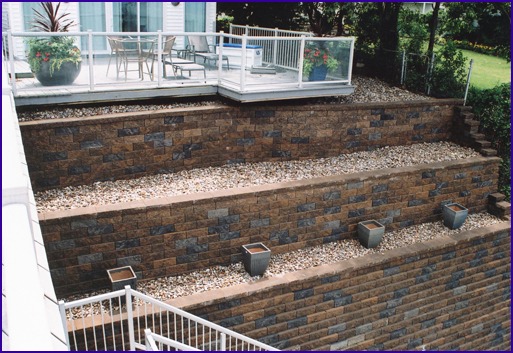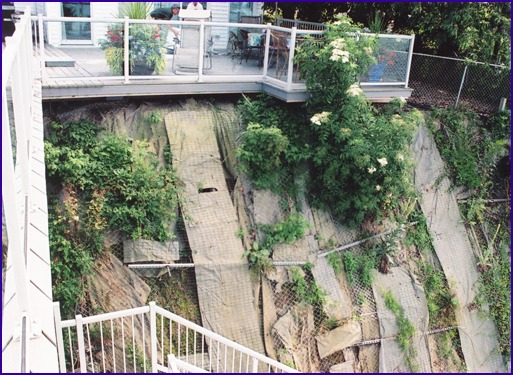Hardscaping Case Study
Retaining Wall Ends Erosion
Versa-Lok retaining walls have been called upon to solve a lot of erosion problems. But few have been as complex or unique as preventing a towering cliff from crumbling into Lake Erie, outside of Cleveland.
The project came to Greg Norton, owner of NCS Construction Services, by way of his father, who owned a home atop a 40-foot bluff overlooking Lake Erie.
“He had a million-dollar home up there but always wanted lake access,” says Norton. The back of the house is positioned only 20 feet from the bluff. However, the cliff face was eroding away, and he was slowly losing his lakefront real estate. The top eight to 10 feet of the cliff is pure topsoil, Norton explains. Beneath that is about five feet of solid clay, which turns to shale as you go deeper.
“The softer shale flakes off but it gets harder as you go deeper,” he says. “The lake eats away at the base of the cliff, but it’s the groundwater at the top that does most of the destruction. First the soil, and then the clay, washes away, and then large pieces of rock.”
Norton and Chris Andrassy, a civil engineer with Andrassy Engineering in nearby Bay Village, whose specialty is designing erosion-control structures on the big lake, first attempted to control the erosion in 2001. After securing the necessary permits from the Ohio Department of Natural Resources and U.S. Army Corps of Engineers several years ago, they placed large boulders called “armor stones” in the lake, 20 feet from the shore, to break the wave action.
When that didn’t work, a couple of years later, a concrete seawall was poured, which rose 13 feet out of the water from the base of the cliff.
“We didn’t cover the rest of the cliff,” says Norton. “We tried to get vegetation to grow, but we couldn’t get anything to sustain.”
Still looking for a solution, Norton’s father wanted to use a segmental retaining wall to cover the rest of the bluff face. So Norton contacted Andrassy again.
“I’d done different kinds of retaining walls – SRWs, sheetpile, seawall blocks – but??on these kinds of walls, when you’re looking at using a geogrid, you’ve got to have adequate space in your backfill to lock into,” Andrassy says. In this case, there was little room for geogrid, so a different type of anchoring system had to be used.
Andrassy started researching alternatives and determined that anchor bolts could be used to secure the geogrid to the bluff.
“I’d been interested in that technology for awhile working on these bluffs. So I went through different literature, got some data on the bond strength and ways to distribute anchorage capacity across the wall,” says Andrassy. “There are probably different types of anchorages we could have used. We did hydraulic ram tests on a couple of the anchors we selected to make sure they’d hold.”
Using a 2.5-inch drill bit, holes were drilled six to seven feet into the cliff face and anchor bolts cemented into the borings. Seventy-five holes were drilled, 12 for each course of block with geogrid. Then a steel bar was attached to the anchor bolts and the geogrid attached to the steel bar to secure the wall to the cliff face.
“Greg was careful about the drilling,” says Andrassy. “He made sure he had plenty of depth, and in a lot of cases he probably over-drilled them. It was a pretty conservative design. Since you’re dealing with some unknowns and with the nature of the rock – hard, competent rock to more crumbling rock – you’ve got to err on the side of caution.”
The existing seawall was used as the footing.??The concrete wall extends upward for 17 feet and an 18-inch cap on top rests on a ledge chiseled out of the cliff face. The Versa-Lok wall rests on top of the cap. The seawall required about 600 cubic yards of concrete.
Once the footing was completed, a series of three decks was built that jutted out from the cliff and was connected to a pier on the water by zig-zagging stairways. The retaining wall was built behind the deck/stairway structure.
The Versa-Lok wall begins at about 13 feet above the water level. It’s 65 feet wide and 27 feet tall, and was built in three tiers with a slight curve.
“That allowed us to follow the bluff face,” Andrassy says. “The nature of the bluff face was such that the lower two-thirds were very steep, nearly vertical. The rock transitions to soil at the top, so it starts to fall back. That allowed us to bench into the existing face, so each segment has its own footing.”
About 3,000 Versa-Lok Standard units in a blended pattern of 80 percent brown and 20 percent gray were used. A special conveyer belt system was designed to lower the blocks down the cliff face one by one; a chute alongside the conveyer was used to transport the backfill aggregate.
“The higher we went with the wall, we had to adjust our system of transport,” says Andrassy. “We had a little innovation going on. Everyone got a good workout. No matter how good you are at moving it, that’s a lot of block.”
“With its flexible slot-and-hole pinning system, Versa-Lok was perfect for the application,” says Norton. “One of the biggest challenges of the job was explaining to people what it was going to look like when it was done. The other big challenge was getting the material down there. But I like the challenge. I don’t like cookie-cutter designs.”
This was definitely not a cookie-cutter design, and it may not be the last such wall he designs, says Andrassy.
“There are all these million-dollar houses up here and none of them can get down to the water,” he says. That may change once the neighbors see this wall.


